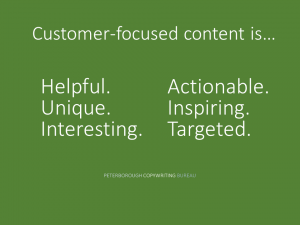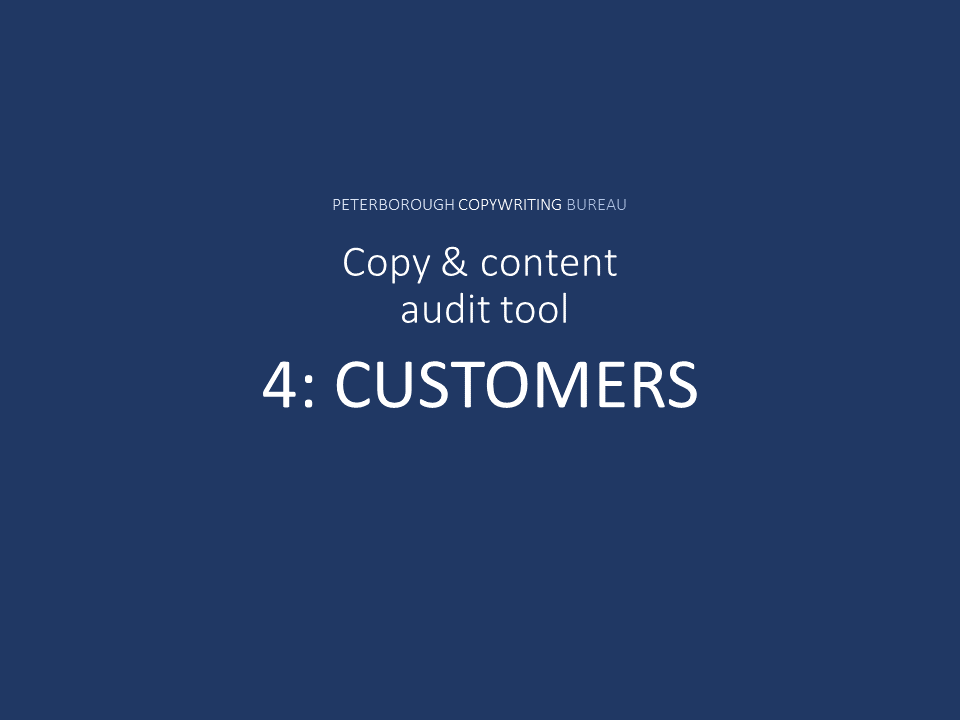Keeping your writing focused at all times on customers is the key to great copywriting.
The audit has already made a start on this, but now is the main place to ask whether the piece is really focused on the readers (which usually means customers or potential customers). In short, is this something they will want to read and then be glad that they did?
NOTE: This is part 4 in a ten-part serialisation of my eBook. Please read the introduction first if you are new to the tool.
This is perhaps the most important of all the ten criteria covered in this audit tool. It’s also often the hardest one to get right, because there’s a natural tendency for people to think about things from their own perspective, and not their customers.
Think about how many times that, as a reader of other people’s marketing content, you have been disappointed or frustrated by what you’ve read. How many times have you clicked away from a page within seconds because the content doesn’t do anything for you?
If you are committed to providing content that is genuinely of interest to readers and that adds value to them, once again you need to take a very tough and objective standpoint at this stage of the audit. Is the piece authentic, accurate, well-researched and up-to-date? In short, is this something people will want to read and then be glad that they did?
And of course, unique, helpful, targeted content is exactly the type of thing that Google loves. Much of your SEO efforts should probably be focused around this sort of content.
How to spot customer-focused content
Here’s a handy list of qualities that you can use to help with this assessment. The content may not fulfil all of them, but it should probably score well on at least some of them:

-
HELPFUL. Readers can do something better after reading it.
-
UNIQUE. It’s information that readers can’t get elsewhere, or if they can, they might struggle to find it all in one place.
-
INTERESTING. The content may not have any practical value, but it’s informative nonetheless.
-
ACTIONABLE. The readers can go and do a specific task after reading the piece.
-
INSPIRING. The content will inspire emotion, changing how people feel.
-
TARGETED. It’s clearly aimed at a specific segment, persona or situation.
On the other hand, content that isn’t customer-focused probably looks like this:
-
USELESS. It might be trying to help, but really it isn’t.
-
OBVIOUS. It’s all stuff that the reader already knows.
-
GENERIC. Lots of content is available elsewhere that says the same thing.
-
BORING. Even if the subject matter is good, the writing style is totally uninspiring.
-
FOR EVERYONE. There’s nothing specific to any particular type of reader. By trying to appeal to everyone, you appeal to no-one.
Some solutions to ‘customers’ problems
Here are three of the approaches I use to fix problems with copy or content that isn’t customer-focused.
Option 1: pick a specific topic and focus on it
Sometimes there is one aspect of a piece that has the potential to be very customer-focused, but it’s lost in a sea of less relevant information.
By editing with a focus on a specific topic you can often create something that is much more interesting and relevant to readers. It’s about getting rid of the padding and getting to the heart of what matters to your readers.
Option 2: focus on a specific type of customer
Another way to cut through the issue is to focus very much on a specific type of customer, and edit the content with that persona in mind.
An article on ‘first steps in creating a garden’ is OK. But even better is something targeted, like ‘first steps in creating a garden for your new build home’. It could be very specific about the problems of gardens in new homes, including the likelihood of poor soil, the need for planning and the homeowner’s desire to get quick results.
On the other hand, someone moving into an old house with a well-established garden has different problems. They might need advice on which plants to remove, how to freshen up tired soil, and so on.
The more a piece is targeted at certain segments/personas, the more likely it is to have true value and interest for them.
Option 3: move the reader on to better stuff
It’s not a very satisfactory option, but you could own up to the fact that the piece isn’t very thorough like this:
‘This is just a quick look at a few of the issues you need to get right when maintaining your garden pond. For a much more detailed view of what’s involved, please visit our garden pond maintenance guide or contact us with any questions.’
< Back to part 3: ‘Comprehensive‘
Coming next in part 5: ‘Clickable’. In the meantime, please contact me if you would like more information, the complete ten-part ‘Copy and content audit tool’ eBook, or a free 50-minute coaching call to help you apply the tool in your business.

